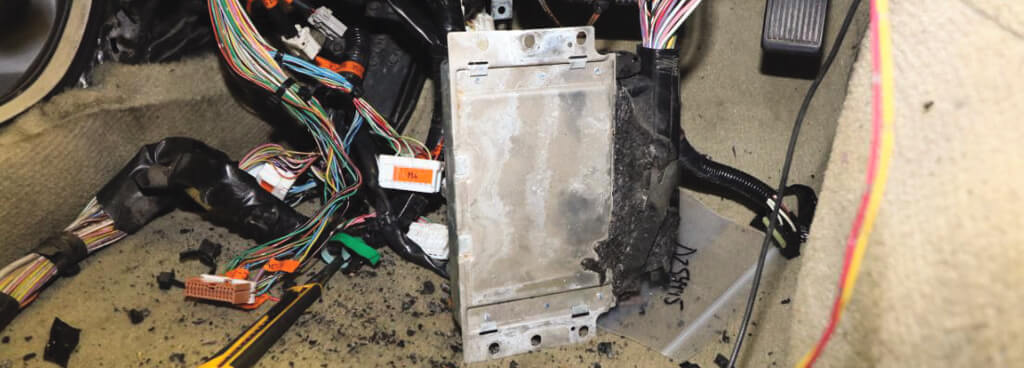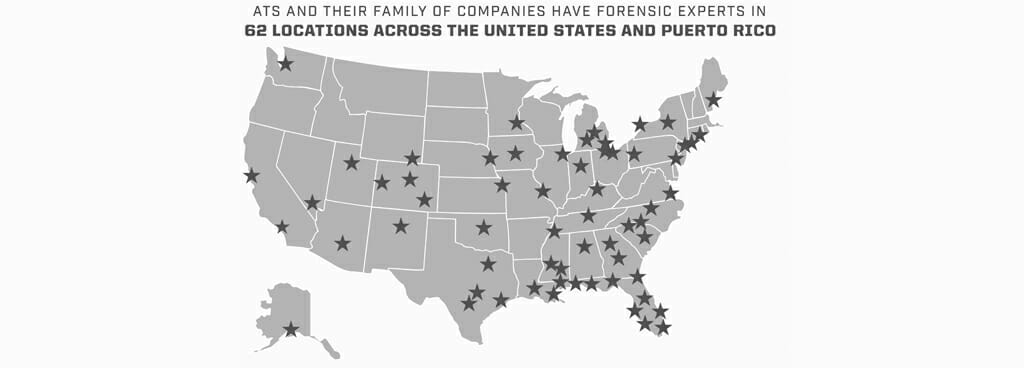- Home
- Services/IndustriesServicesindustries
- About Us
- LocationsStatesAccordion ContentAccordion ContentAccordion ContentAccordion Content
- Job Openings
- Quick Links
- ATS Family

An Introduction to Arc Mapping
For the insurance professional concerned with fire investigations, it is important to effectively choose and communicate with those you rely on for a proper investigation. This article is intended to better inform you of a tool known as Arc Mapping. The goal is to provide a brief introduction to the subject matter to keep in perspective how this tool can be beneficial, and the roles investigative professionals can play during an origin and cause analysis.
What is Arc Mapping? NFPA 921 section 3.3.8 (for this article, the 2014 edition is cited) states the following:
Arc Mapping: The systematic evaluation of the electrical circuit configuration, spatial relationship of the circuit components, and identification of electrical arc sites to assist in the identification of the area of origin and analysis of the fire’s spread.
At face value, the investigator draws a map (sketch) depicting all of the electrical circuits in the fire zones of interest—wiring, outlets and appliances etc. Then locations where electrical activity (arcing) is present are added to the map followed by spots where wiring has suffered melt damage. Finally, a note of the breaker condition for the circuits of interest are made. Investigators then combine this knowledge with the other tools of fire investigation (witness information, burn patterns, fuel sources and ignition sources) for added insight as to the area of origin and cause of a fire.
On a good day, Arc Mapping can provide key information with regard to the area of fire origin; and on some occasions even assist with the determination of the cause of the fire. At other times the mapped activity does not bear fruit. Like any tool, at times it is indispensable and at other times it’s like using a hammer to tighten a bolt. An insurance professional should be wary of an investigator who is overly smitten with this procedure or overly dismissive.
For those that have not lived an overly sheltered life, you produced an electrical arc when you walked across carpeting in your socks and purposely zapped someone. Your electric potential changed as you were walking such that when your finger almost touched the person of differing potential, a momentary flow of electricity passed between the two of you. In addition to feeling the arc you may have actually seen the arc (spark).
The manufacturers of extension cords, appliance cords and general electrical wiring fortunately insulate the wires to prevent arcing between them. This layer of insulation between the copper wiring does a great job of preventing arcs. But when these same electrical conductors are attacked by fire, the fire’s heat and flames break down this insulation such that at spot locations the only thing separating the wires is an air gap. To make matters worse, the fire damaged insulation can produce “char” that encourages electrical activity across these air gaps. When the ingredients are just right (spacing, char and voltage difference), an electrical arc ensues.
When an arc occurs between the cord wires, the results are much more dramatic than when you gave that “carpet shock” to the unsuspecting “friend” (cat, significant other, annoying child). Not only is the spark more vivid, this electrical activity physically damages both of the almost touching copper wires leaving forensic clues behind for the investigator to discover. The heat generated at an arc site can momentarily raise the wire’s temperature a couple of thousand degrees (°F). Permanent damage takes place in the form of copper beading, craters formed in the copper wire, and copper splatters on the wires or nearby surfaces. Each electrical arc is extremely brief but very violent.
So what is so special about the discovery of arc damage? One does not need to find evidence of arcing to know that an electrical conductor had been attacked by fire. There is plenty of evidence left behind in the form of degraded and missing wire insulation for starters.
The discovery of arc damage signifies to the investigator that the electrical cord at that localized area was energized at the time of the fire attack. The science associated with Arc Mapping is founded upon that one simple truth. Arc Mapping can provide a time dimension to the other forms of evidence which includes witness statements, burn patterns, ignition sources and fuel sources.
For example, suppose a kitchen fire has heavily damaged the appliances including a toaster. The homeowner claims that the toaster had been unplugged prior to them leaving the house. But the investigator discovers arc damage on the toaster’s cord. This contradictory physical evidence adds value to the overall analysis.
In the previous example, at first glance, it appears the home owner was either not being truthful or forgot the toaster was still plugged in. After all, if the toaster was not plugged in, how could there have been an arc if no electrical current was flowing? Well … suppose during the fire the power cord for a nearby coffee maker cord had been draped over the toaster cord. While both cords were attacked by fire, their insulation broke down in such a way that electrical current in the coffee maker cord energized the unplugged toaster cord enabling an arc to occur in this cord.
As with any technique, the investigator must be aware of the subtle nuances associated with the supporting science. Some other complications (not discussed in this article) include direct versus alternating current, copper versus aluminum wiring, and 120 voltage versus 240 or 480 voltage. There are numerous texts and published papers addressing this topic. NFPA 921 devotes eight pages just informing how the investigator is to identify and distinguish arc damage from other fire related damage.
So who should you turn to for technical guidance? According to NFPA 921, a fire investigator who is well versed in the methods of their guidelines. NFPA 921 section 9.11.7.2 states the following:
An electrical engineer is not required to perform Arc Mapping. Arc Mapping is fundamentally a pattern recognition, which fire investigators routinely perform in other areas of fire investigation.
However, a good investigator knows there are instances when the services of an electrical engineer or metallurgist are warranted.
In summary, Arc Mapping is a tool based on a simplistic truth that an electrical conductor must have been energized at the time of arc damage. However, the underlying science is both subtle and complex. Arc Mapping is an important technique to be considered for fire investigations involving electrical power; but is not a cure-all solution.


Request Form
"*" indicates required fields
Forensic Services
- 3D Laser Scanning
- Accident Reconstruction
- Accident Reconstruction Animation
- Accident Reconstruction Engineering
- Accident Reconstruction Experts
- Accident Reconstruction Services
- ACTAR - Traffic Accident Reconstructionist
- Arc Mapping
- Arson Investigators
- Asbestos Testing Lab
- Automotive Expert Witness
- Black Box Data
- Boilers, Vessels & Piping Failure Analysis
- Bosch Crash Data Retrieval
- Certified Arson Investigator
- Certified Fire Investigator
- Certified Forensic Expert
- Climate-Controlled Evidence Storage
- Construction Defect Expert Witness
- Construction Equipment Expert Witness
- Construction Expert Witness
- Crash reconstruction
- EDR Event Data Recorder Analyst
- Electrical Forensic Analysis
- Electrical Forensics
- Elevator Expert Witness
- Elevator Inspections
- Event Data Recorders
- Evidence Storage
- Evidence Storage Services
- Expert Witness Companies
- Expert Witness Services
- Explosion Investigations
- Farm Fire
- Fire Cause Analysis
- Fire Cause Investigation
- Fire Debris Analysis
- Fire Forensic Data Collection
- Fire & Forensic Investigation Updates
- Fire Investigation Company
- Fire Investigation Companies
- Fire Investigation Services
- Fire Investigator
- Fire Investigator Atlanta, GA
- Fire Investigation Expert Witness
- Fire Retardant Standards
- Fire Scene Investigaton
- Fire Scene Investigators
- Firearms Testing
- Forensic 3-D Site Scanning Service
- Forensic 3-D Scanning
- Forensic Accident Reconstruction
- Forensic Assignment Form
- Forensic Building Consultants
- Forensic Chemical Analysis
- Forensic Construction Expert
- Forensic Crash Specialists
- Forensic Electrical Engineer
- Forensic Engineering Consultants
- Forensic Engineering Expert
- Forensic Engineering Expert Witness
- Forensic Expert Witness
- Forensic Fire and Explosion Investigators
- Forensic Fire Investigation
- Forensic Fire Investigations
- Forensic Fire Investigation Services
- Forensic Imaging Specialist
- Forensic Lab Testing
- Forensic Locksmith
- Forensic Metallurgist
- Forensic Metallurgy
- Forensic Specialist
- Forensic Structural Engineer
- Forensic Structural Engineering
- Forensic Structural Engineering Firms
- Forensic Testing Service
- Forensic Thermal Imaging
- Forensic Tire Expert
- Forensic Water Damage Evaluation
- Forklift Expert Witness
- Golf Cart Expert Witness
- HAAG Certified
- Hail Damage Roof Inspection
- Handgun Testing
- Hurricane Structural Damage Evaluation
- Hurricane Structural Damage Inspection
- IAAI Certified Fire Investigator
- Incident Reconstruction
- Industrial Accident Investigation
- Infrared Thermal Imaging Services
- Joint Inspections
- Lap Shear Testing
- Large Loss
- Litigation Expert Witness
- Litigation Support
- Maritime Expert Witness
- Mechanical Forensics
- Natural Disaster Inspections
- Precision Forensic Testing
- Product Liability Expert
- Product Liability Expert Witness
- Secured Evidence Storage
- Special Services
- Speed Control Deactivation
- Structural Analysis
- Structural Fire Damage Assessment
- Structural Investigation
- Tire Failure Expert
- Traffic Accident Reconstruction
- Thermal Imaging
- Thermal Imaging Services
- Traffic Accident Reconstruction
- Truck Accident Expert Witness
- UTV/ATV Expert Witness
- Vehicle Fire Investigations
- Water Damage Inspection
